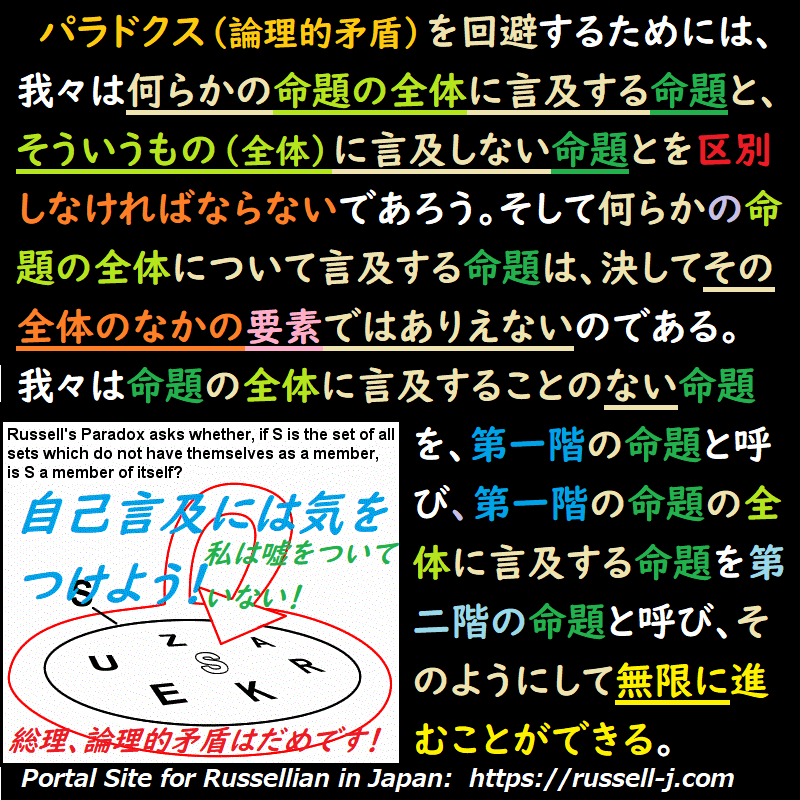
(論理的矛盾の)解決策が満たすべき上記の三つの条件の第三のものに関して、私はある理論を展開したが、他の論理学者達は気に入らなかったように思われる(commend oneself ~に気に入る)。しかし、私は、その理論は今でも(理論として)正しい(sound)と思われる。その理論は以下の如くであった。私がある関数 fx の全ての値を主張する時、私の主張するところが明確(definite 確定的)であるならば、x がとりうる値もまた明確(確定的)でなければならない。即ち(that is to say 還元すれば)、x のとりうる値のある種の全体(注:totality 可能な値の全体が定まること)が存在せねばならない。もし私が今進んでその全体によって定義される新たな値をつくり出すならば、その全体はそれによって拡張されるように思われ、従って、全体に言及するその新たな値は、その拡大された全体に(も)言及するであろう。しかし、それらの値はやはりその全体に含まれなければならないので、決してその全体に追いつくことはできない。この過程は我々が自分の頭の影に飛びつこうと試みることに似ている。このことを極めて容易に、あの嘘つきのパラドクスによって例示することができる。(即ち)その嘘つきは「私の主張することは全て偽である(間違っている)」と言う。これは実際、彼のなす主張の一つであるが、しかしそれは、彼の主張(群)の全体に言及している。パラドクスが(結果として)生ずるのは、そういう(全体に関する)主張を、その主張の全体の中に含めることによってのみなのである。(そこで)パラドクスを回避するためには、我々は何らかの命題の全体に言及する命題と、そういうもの(全体)に言及しない命題とを区別しなければならないであろう。そして命題の何らかの全体について言及する命題は、決してその全体のなかの要素ではありえないのである。我々は命題の全体に言及することのない命題を、第一階の命題と呼び、第一階の命題の全体に言及する命題を第二階の命題と呼び、そのようにして無限に(ad infinitum)進むことができる(訳注:第二階の命題の全体に言及する命題は第三階の命題/型の説=タイプ理論という名称はここから来ている)。そこで今やこの嘘つきは「私は、偽である第一階の命題を主張しており、その主張は偽である」と言わなければならないであろう。しかし彼(この嘘つき)が言っている命題そのものは第二階の命題である。従って彼は決して第一階の命題を主張しているのではない。従って,彼の言っていることは単純に偽であり、従って、それがまた真でもあるという論拠(議論)は消滅する、これと全く同様の論法が、より高次のいかなる命題にもあてはまる。 あらゆる論理的パラドクスの中に、同じ理由で非難されるべき(斥けられるべき)一種の反射的な自己言及(注:reflexive self-reference/みすず書房刊の野田訳では、”refer to” 及び”self-reference”はそれぞれ「指示する」「自己指示」と訳されているが、現在ではそれぞれ「言及する」「自己言及」と訳すのが通常。「指示」よりも「言及」のほうがわかりやすい。)があるということが見出されるであろう。つまり(viz.)、ある全体のなかの要素(成員)としての、自己言及は、もし全体が既に確定されれば、その時のみ確定した意味をもつような全体に言及するなんらかのもの、を含んでいるのである。 私はこの「型の学説」(タイプ理論)が、広くうけいれられていないと告白しなければならない。しかし、それに対するいかなる反論も、私には、カあるものとは思われれなかった(今も思っていない)。
Chapter 7: Principia Mathematica: Philosophical Aspects, n.11 As regards the third of the above three requisites which a solution should fulfil, I advanced a theory which does not seem to have commended itself to other logicians, but which still seems to me sound. This theory was as follows: When I assert all values of a function fx, the values that x can take must be definite if what I am asserting is to be definite. There must be, that is to say, some totality of possible values of x. If I now proceed to create new values defined in terms of that totality, the totality appears to be thereby enlarged and therefore the new values referring to it will refer to that enlarged totality. But, since they must be included in the totality, it can never catch up with them. The process is like trying to jump on to the shadow of your head. We can illustrate this most simply by the paradox of the liar. The liar says, ‘everything that I assert is false’. This is, in fact, an assertion which he makes, but it refers to the totality of his assertions and it is only by including it in that totality that a paradox results. We shall have to distinguish between propositions that refer to some totality of propositions and propositions that do not. Those that refer to some totality of propositions can never be members of that totality. We may define first-order propositions as those referring to no totality of propositions; second-order propositions, as those referring to totalities of first-order propositions; and so on, ad infinitum. Thus our liar will now have to say, ‘I am asserting a false proposition of the first order which is false’. But this is itself a proposition of the second order. He is thus not asserting any proposition of the first order. What he says is, thus, simply false, and the argument that it is also true collapses. Exactly the same argument applies to any proposition of higher order. It will be found that in all the logical paradoxes there is a kind of reflexive self-reference which is to be condemned on the same ground: viz. that it includes, as a member of a totality, something referring to that totality which can only have a definite meaning if the totality is already fixed. I must confess that this doctrine has not won wide acceptance, but I have seen no argument against it which seemed to me cogent.
Source: My Philosophical Development, chap. 7:1959.
More info.:https://russell-j.com/beginner/BR_MPD_07-110.HTM
